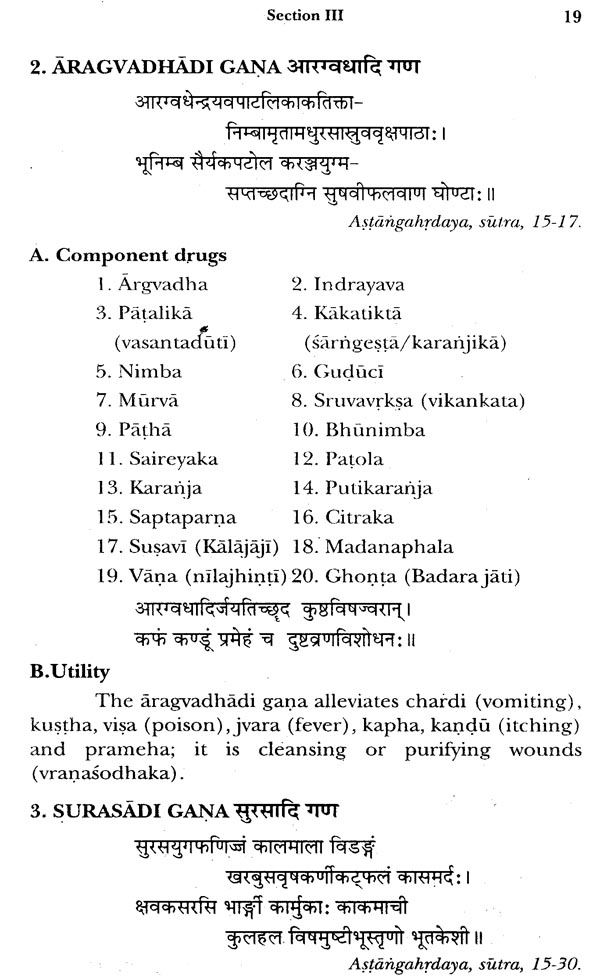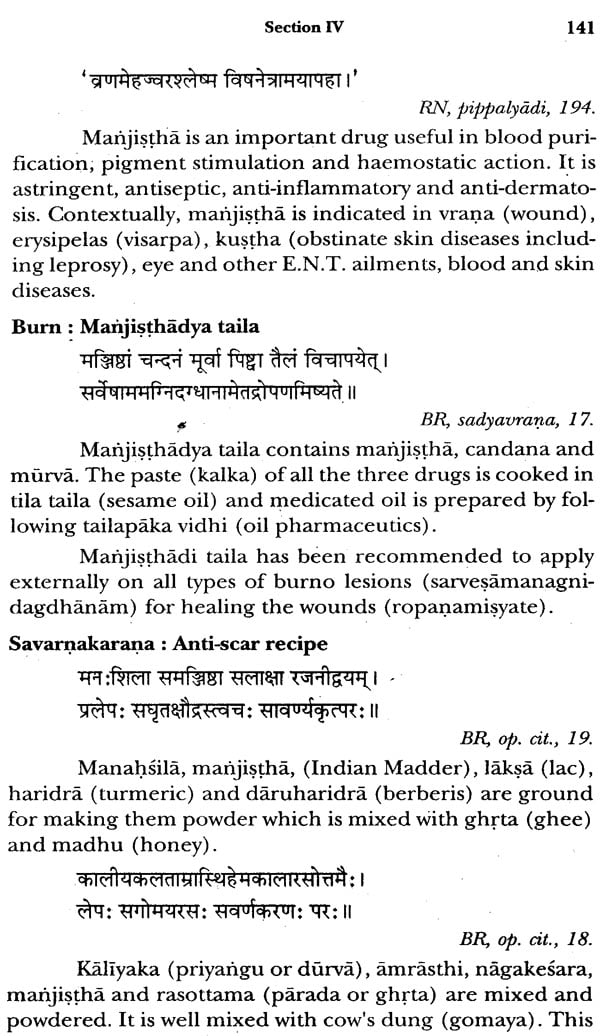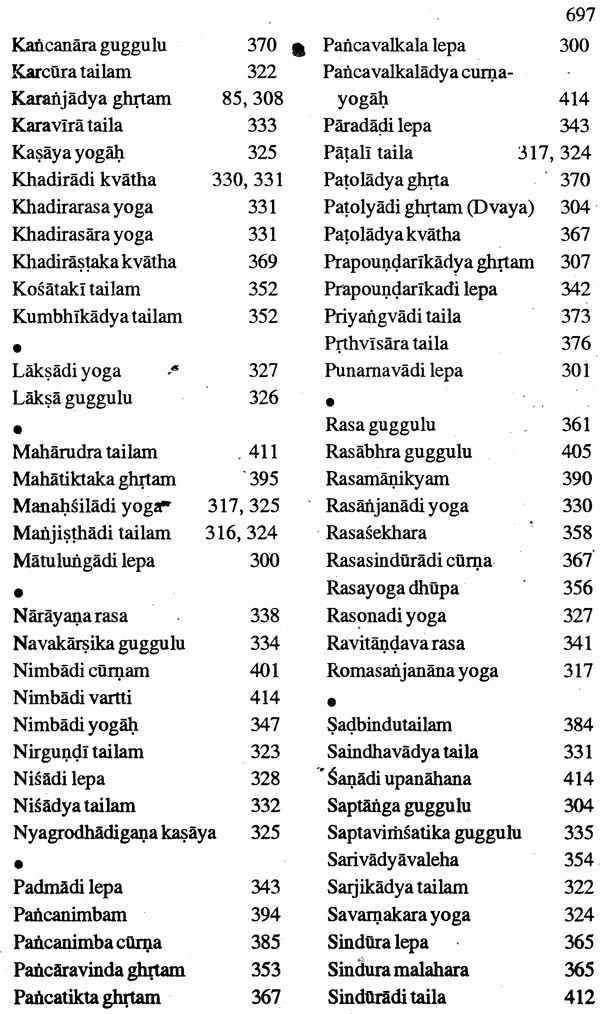
Wound Healing Drug Therapy: Vranaropana Ausadhi Vijnanam
Book Specification
| Item Code: | IDF265 |
| Author: | Prof. (Dr.) Gyanendra Pandey |
| Publisher: | Chowkhamba Sanskrit Series Office |
| Language: | English |
| Edition: | 2004 |
| ISBN: | 8170801435 |
| Pages: | 703 |
| Cover: | Hardcover |
| Other Details | 8.8" X 5.4" |
| Weight | 860 gm |
Book Description
Physiopathological studies on wounds and their healing find that the mechanism of wound healing as a` whole is a complete biological process which is fully characterized at the microscope level but there appears poor understanding or more need to understanding the wound healing process at molecular level. The healing process makes progress or follows in phases through three stages viz. (a) inflammatory, (b) proliferative and repair, and (c) remodelling stage. The review and observation on; scientific and medical advancements record major improvement and constant development in almost all branches of surgery, but the progress in improving wound healing process appears to be little or further studies on aspect of wound healing need to be conducted comprehensively.
The mechanism of wound healing depends on certain factors which have centered mainly on the prevention of vitamin, trace element and protein deficiencies that de-lay wound healing or lead to wound breakdown. It was only with the advent of growth factors that the idea of enhancing normal healing by therapeutic manipulation had gained importance. However, there are reports on chemical agents that promote wound healing, but they are scarce and requiring various desirable effects and needs of healing feature for its betterment. Hence, the attention is now diverted for searching alternate drugs for which indigenous drugs belonging to Indian medical system as well as traditional medicine are being given priority for investigating their efficacy as wound healing drug. This kind of re-search is not only required to assess their efficiency in hastening healing process-shortening time limit or duration necessary for healing of the wound, but those potent drugs Tare required which can beneficially modify healing to minimize end results of abnormal healing such as over-healing (keloids, hypertrophic scars etc.), under healing (wound dehisions, scars, hemias etc.) and also delayed or slow-healing of various types of wounds. Thus, faster, safe and proper process of healing of wounds is medical need of management of wounds in general.
Series of studies have been conducted on a number. of plants drugs which have been reported to possess wound healing properties based on medical texts and traditional practice of medicine. Studies have been carried out on several medicinal plants on their various aspects related to wound healing through different methods by applying certain parameters. Biochemical, biological and pharmacological investigations on drugs of plant sources. Observations and results of these multi disciplinary studies are significant from different points of view that include successful response as good wound healer agents coming from herbal drugs finding their origin of knowledge and medical practice in Indian medical science.
A study on eight plants has been conducted by screening them to ascertain the medicinal potentials as prohealers. Incision, excision and dead space wound models in rats have been employed, and the action of these herbal drugs on normal and steroid—depressed (dexam-ethasone) healing as well as on the inflammatory process has been studied. Out of eight herbals, four plant drugs have been undertaken for investigation. They are: Aegle` marmelos (bilva), Aloe vera (Kumari), Moringa olefera` (sigru) and Tridax procumbens (pita bhrngaraja bheda). These medicinal plants have showed promising action, as evidenced by increase in tensile growth of the wounds, an increase in the protein, nucleic acid, and glycosammunoglycan contents. In the process of wound healing, the increase in tensile strength is considered due to better maturation of collagen. Under the mechanism of healing, the levels of Iysyl oxidase are examined to evaluate the enzyme which is responsible for cross-linkage of collagen. These levels of Iysyl oxidase have been found to be in-creased during course of wound healing. The herbal drugs, have been assessed for their efficiency as wound healing agents. Observations recorded to find active effect of the trial drugs. Results indicates that the herbal drugs investigated, have promoted epithelisation and reduced wound contraction. They have also been found to be capable in overcoming dexamethasone which has suppressing action against healing.
The observations taken during studies on Tridax procumbens have specifically shown a different mechanism with progress of healing. It is revealed that the plant drug has differential action on various phases of healing an initial prohealing action but anti-healing effect (mediated by a corticotropic effect) in the later phases of healing.
It is remarkable that analysis of various fractions of herb Tridax procumbens under investigation have shown that pro healing principles are to be located in the aqueous and whole leaf extracts, while the anti-healing constituents reside in the butanol and petroleum ether fractions. Results, as a whole, confirm wound-healing effect of her band leaves of Tridax procumbens (pita bhrngaraja orbhrngaraja bheda). Similarly other plant drugs tested for their healing efficacy have shown their activity on wounds and confirm wound healing potentialities in general.
There is need to study corelational facet of healing with association between anti-inflammatory and wound healing from biochemical, pathological and pharmacological points of view. Because wound healing drugs generally have anti—inflammatory effects to various extents, if not in _all the drugs but in many drugs which are used in wound treatment. Since anti-inflammatory activity of drugs is inter-related with wound healing action having pathopharmacological implication, the study of anti-inflammatory activity while investigation healing drug activity in relation to wound carries analogical importance on its effective role in clinical management of wounds in order to utilise synergy of activities, i.e. analgesic, anti-inflammatory -haemostatic and healing action, which is the basis of wound healing potential of many drugs.
Various drugs selected for experimental investigations - biochemically and biologically are found to have potent anti-inflammatory action, in association with wound healing activity in addition. Pathologically, the wound and inflammation are interrelated, or in other way, any injury is liable to cause inflammation to any extent depending on various factors right from on set of ailment to complicatory stage of diseases leading to relief as the result of proper wound healing drug possessing also anti-inflammatory effect.
A question ponder's before the scientific research whether a wound healing drug may have anti-inflammatory action or an any drug having an anti-inflammatory activity may show prohealing effect. Pathogenesis of wound discussed under surgical principles determines that wounding or ulceration will initiate or manifest inflammation since wound is basically caused by break in the continuity of soft parts resulting from trauma of tissues and this condition leads to characterize inflammation that is actually tissue re-action to injury or trauma (covering various causative factors), directly or indirectly. This in turn stimulates the production of free radicals by phagocytes; one of the few beneficial effects of free radicals by virtue of their microbi-cidal, cytolytic and chenotactic activities.
There is natural phenomenon that the cells them-selves are protected from these radicals by various anti-oxidants systems, and however, part of these free radicals leave the cells and enter the extra cellular space where anti-oxidant protection remains weak, so succiptible for any abnormalcy due to production and act of free radicals. Further, it could damage healthy cells, inhibit mycofibroblast proliferation and thereby retard the healing process of a wound. In this direction, the experimental studies on wound healing drugs when conducted yield applied and dependable information regarding role of free radicals during the process of action shown by healing drugs.
Various investigations are carried out on wound healing activity of drugs from various angles, and also to assess participation of free radicals. There is a view that the drugs in the form of raw material-crude drug as a whole (as generally used in traditional medicine), in the form of crude preparations. Naturally when the recipes or any com-pound prepared with crude drugs are taken for clinical use, such drug preparations, because of their complexity of active components of herbal ingredients, tend to exhibit mixed action as complex activity due to chemical constituents and their pharmacological effects on the cells of affect body organs. \\'hen any component proves to be active to decrease or prevent the entry of free radicals it is very likely that it has both anti—inflammatory as well as prohealing action of drug attributed to its active component.
| Section I | Process of Wound Healing: Studies and Trends | 1-6 |
| Section II | Wound Healing Drugs (185) | |
| Plant Drugs Useful in Wounds and Various Allied Diseases | 6-18 | |
| Section III | Groups (Gana) of Drugs Ausadha Dravyas | |
| Recommended for purifying (Sodhana) and Healing (Ropana) of Wound (Varna) | 18-23 | |
| Section IV | Wound Healing Drugs of Ayurveda | 24-191 |
| Section V | Wound Healing Plant Drugs in Traditional Medicine (526) | |
| Medicinal Plents Useful in Wound and Allied Ailments. | 192-284 | |
| Section VI | ||
| Part A | Wholesome Articles and Conducts | 285-299 |
| Part B | Compound Formulations: Wound Healing | 300-415 |
| Part B-I | Major Drug Formulations | 416-422 |
| Part B-II | Other Useful Drug Formulations | 423-428 |
| Part C | Therapeutic Directives for Allied Diseases: Measure for Vrana | 429-431 |
| Part D | Some Observations on Drugs formulations | 432-442 |
| Section VII | Textual Excerpts | |
| Clinical and Surgical Excellence of Ayurveda Indian Contribution to Wound Healing Therapy | 443-444 | |
| Supplement I-III | ||
| I. | Wound and Ulcers: At a Glance | |
| Group A: Wound-Group B: Ulcer | 667-678 | |
| II. | Quality Conversion in the Wound Healing Drug Formulations | 679-681 |
| III. | On Looking Studies on Wound Healing Process | 682-691 |
| Indices | ||
| A. | Major Classical Herbal Drugs | 692-694 |
| B. | Compounds Classical Formulations | 695-697 |













